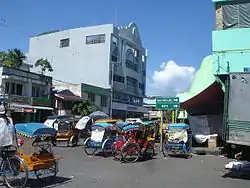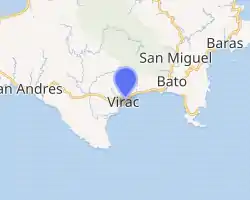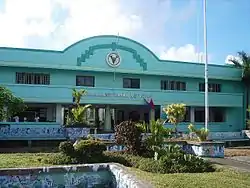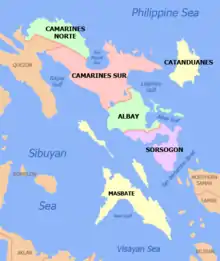Virac, Catanduanes
Virac, officially the Municipality of Virac, is a 1st class municipality and capital of the province of Catanduanes, Philippines. According to the 2015 census, it has a population of 73,650 people. [3]
Virac | |
|---|---|
| Municipality of Virac | |
 Downtown area | |
 Flag  Seal | |
 Map of Catanduanes with Virac highlighted | |
OpenStreetMap 
| |
.svg.png.webp) Virac Location within the Philippines | |
| Coordinates: 13°35′N 124°14′E | |
| Country | |
| Region | Bicol Region (Region V) |
| Province | Catanduanes |
| District | Lone district |
| Founded | 1775 |
| Barangays | 63 (see Barangays) |
| Government | |
| • Type | Sangguniang Bayan |
| • Mayor | Sinforoso M. Sarmiento Jr. |
| • Vice Mayor | Arlynn H. Arcilla |
| • Representative | Hector S. Sanchez |
| • Electorate | 49,195 voters (2019) |
| Area | |
| • Total | 152.40 km2 (58.84 sq mi) |
| Elevation | 96 m (315 ft) |
| Population | |
| • Total | 73,650 |
| • Density | 480/km2 (1,300/sq mi) |
| • Households | 14,958 |
| Economy | |
| • Income class | 1st municipal income class |
| • Poverty incidence | 26.71% (2015)[4] |
| • Revenue | ₱176,731,427.26 (2016) |
| Time zone | UTC+8 (PST) |
| ZIP code | 4800 |
| PSGC | |
| IDD : area code | +63 (0)52 |
| Climate type | tropical monsoon climate |
| Native languages | Southern Catanduanes Bikol Tagalog |
| Website | www |
It is most populous and fifth largest in land area in Catanduanes.[5]
Etymology

It has been said that Virac is a derivation of the word “Vidak” while others claim it is a contraction of the Spanish version of the word burac, meaning flower. A priest is on a quest for more information about the natives. Pointing to a tree, he asked what it was called and the natives replied, “Burac.” Thereupon, the priest made his first notation on his book of information “burac”.
History
Pre-Spanish period
Civilization first touched the island province of Catanduanes in the thirteenth century, with the arrival of the scions of ten Bornean datus who were then traversing through the islets of the Philippine Archipelago. By the middle of the fourteenth century, organized communities could be seen throughout Catanduanes – a consequence of the rapid development of Southeastern Luzon initiated by the Malay settlers.
Virac, the capital town of the island province of Catanduanes, started its primitive annals in pre-Spanish times when tribal chieftain Lumibao, scion of Datu Dumaguil who came to the Philippines with the 10 Bornean datus and his wife Milbigan settled near Vidak spring and founded the first civilized settlement with a score of servant followers and their wives.
Spanish period
It was the Spanish Conquistadores Juan de Salcedo who first brought Spanish galleons to the waters of Catanduanes in 1573. His purpose then was to capture and punish pirates who carried on their nefarious trade in Camarines Sur, Sorsogon and Western Catanduanes. His galleon returned a few weeks later – this time, his mission was to spread the Catholic faith.
While at bay, the port guard saw smoke rising from the mountain Eli. After dropping anchor, the Spaniards tracked down footprints from the shore which reached a sitio called Vidak. They eventually came upon a large kaingin in Timbean, situated between the barangays of Danicop and Calatagan.
The chieftain of the village had his hut built a little above a spring which still exists today. There was a reception hall conveniently shaded by a tree known as sambong. This tree eventually served as the guidon to the couple’s place.
It is said that the Spaniards could not approach the hut of the chieftain because of three huge fierce-looking dogs and several guards who had their spears drawn toward the foreigners. However, the Spaniards determined to succeed in their mission, returned the threatening acts of the natives with gesture of friendship.
A piece of “onchita” was offered to the chieftain as a gift; but this was rejected by the chieftain when his wife said “we have many pieces of gold in our kingdom”. A silver piece was next offered, but this was similarly rejected by the chieftain and his wife. Reaching for some refined sugar, the Spaniards let the natives taste the sweetness of the substance. The chieftain’s wife like the taste. Thus begun the “sweet” relation between the natives and the Spaniards.
Soon after the first encounters, the Spaniards started giving the natives provisions not found in the chieftain’s hut, such as more sugar and clothing. After the seed of friendship had taken roots, the Spaniards began spreading their message of Christianity. Lumibao was baptized as Jose and Milbigan as Maria. Their son who lived at the bank of Macacao was converted into Christianity with the name of Mariano.
It is unfortunate that records regarding the Christianization of Virac were lost due to vandalism of Moros. The history of this capital town began to be accurately recorded only from the year 1755.
Moro raids
Catanduanes was not spared from the adventurous and plunderous raids of the Moros from Mindanao. But knowing the strength of the coastal batteries of the Virac harbor, the vintas divided into groups and landed at various places or points farther from the range of the coastal batteries. Some landed at Cadaculaan and others way out to points east and west of Virac.
Don Matias Soliman, a famous Moro fighter, engaged in battle and killed a Moro Datu named Mohammed Abu after a bloody encounter in sitio Hopog of Barrio Santo Domingo, Virac. He was aided by the swift-handed and hoarse voiced Don Alipio Alejandro alias Paas.
The non-Christian invaders were superior in arms and number until Don Alipio, with an exotic force, turned the tide. The Moros could not move further, hence, they retreated in defeat.
On the eastern end of Virac, the Moros succeeded in gaining a beach-head in Catanduanes and from there, attacked the town from the east. The Cabeza de Barangay of Francia, Don Pedro Tolentino alias Pantino, lost no time in giving their all against the enemy. This was the first time the people of Virac totally and successfully resisted an organized invasion.
American occupation
A few months after Emilio Aguinaldo, the first president of the First Philippine Republic took his oath of allegiance to America after losing in the Philippine–American War, a battleship dropped anchor in Virac. The American soldiers were on a mission to expedite the surrender of the local Revolutionists or Katipuneros. Not eager to relinquish their hard-fought freedom, the Katipuneros refused to recognize the sovereignty of the United States and fled to the mountains.
In the later part of 1898, when Don Leon Reyes was the incumbent Capitan Municipal [town mayor] of Virac, the revolutionary troops who refused American Administration, came down from the mountains to rally for the common cause. Don Leon Reyes readily welcomed the revolutionists and financed their cause in fighting the Americans. This state of affairs was tactfully handled by the Capitan who spent almost all of his fortunes for the cause. For his patriotic zeal, he was manacled, chained and sentenced to hard labor by the Americans in 1901.
The American occupation ended in 1934 before the establishment of the Philippine Commonwealth in 1935.
Japanese Invasion
Catanduanes was not spared by the forces of the Kamakura Regiment. Airborne planes were cited at the southern portion of Virac in the morning of December 12, 1941, while vessels dropped anchor near Nagngangang Buaya Point, Cabugao Bay. At 9:30 in the morning of said day, towns were totally evacuated. Bombs were soon strategically dropped.
Later, garrisons were established in town and the municipal building was also used as a garrison. No school was regularly opened during the Japanese Occupation. Guerrilla organizations came and went.
Liberation
The Liberation of Catanduanes took place in what is now the municipal building and the Virac Parish Church area. On February 8, 1945, the battle started at Km. 4 at Barangay Calatagan at about 12 noon, and ended with the Filipino soldiers of the 5th, 52nd, 53rd, 55th, 56th and 57th Infantry Division of the Philippine Commonwealth Army and recognized guerrillas taking full control of the Japanese barracks.
On April 20, 1945, Florencio Tacorda, the only three-term Municipal President, some two and a half decades before the war, was designated mayor of Virac. He served for six months and twenty-five days during the Philippine Civil Affairs Unit regime.
Pre and Martial Law Era
From 1958-1970, Salvador Surtida took over followed by Jorge Arcilla from 1970-1986, two of the longest reigning local executives in the history of Virac. This period witnessed the ascendancy to national prominence of the Alberto brothers, Juan, Jose and Vicente, who doubtlessly brought progress and influenced the massive physical transformation of the municipality when Salvador Surtida and Jorge Arcilla were mayors. Foremost among the many infrastructure projects were the Catanduanes State Colleges and the Eastern Bicol Medical Center which placed Virac in the map as a major educational and health center in the Bicol Region.
The growth of Virac in terms of governance peaked in 1972. From the original 34 barangays in 1960, Virac was able to establish 29 new communities to upgrade to the present composition of 63 barangays.
EDSA Revolution and beyond
The EDSA Revolution in 1986 which toppled down the more than two decades of Marcos regime had a domino effect on the political structure of Virac. The replacement of the elected officials by appointed officials was in accordance with the Freedom Constitution which predominated during the revolutionary government from 1986 to 1992. Rodulfo Sarmiento, a doctor by profession held the reins of the municipal government.
The early nineties saw the alternate changing of local governance between Rodulfo Sarmiento and Jose "Cito" Alberto II, the son of Congressman Jose Alberto.
Geography
The municipality of Virac occupies the southern tip of the island province. It has a total land area of 18,778.4 hectares. Of its total, 9,359.15 hectares or 49.84% is forestland while 9,419.25 hectares are classified as alienable and disposable.
Almost half of the area is rugged and mountainous, with hills and plains dotted with marshy land, rocky jutting cliffs and crags.
The town is bounded on the east and south by the Pacific Ocean, on the north by high and green mountain ranges of San Miguel, and on the west by the gently rolling hills of San Andres.[5]
Climate
Virac has a Type II climate. It has no dry season and an average precipitation of between 2,500-3,000 mm/annually.
Virac's position in the middle of the typhoon belt means that it is heavily affected by typhoons from July to October. The region's dependence on agriculture means that economic development has always been hampered by these weather disturbances.[6]
| Climate data for Virac, Catanduanes (1981–2010, extremes 1908–2012) | |||||||||||||
|---|---|---|---|---|---|---|---|---|---|---|---|---|---|
| Month | Jan | Feb | Mar | Apr | May | Jun | Jul | Aug | Sep | Oct | Nov | Dec | Year |
| Record high °C (°F) | 34.3 (93.7) |
36.6 (97.9) |
35.2 (95.4) |
35.1 (95.2) |
37.2 (99.0) |
37.2 (99.0) |
36.6 (97.9) |
36.7 (98.1) |
36.8 (98.2) |
36.0 (96.8) |
35.0 (95.0) |
34.4 (93.9) |
37.2 (99.0) |
| Average high °C (°F) | 29.0 (84.2) |
29.5 (85.1) |
30.4 (86.7) |
31.4 (88.5) |
32.1 (89.8) |
32.0 (89.6) |
31.5 (88.7) |
31.8 (89.2) |
31.6 (88.9) |
30.9 (87.6) |
30.3 (86.5) |
29.4 (84.9) |
30.8 (87.4) |
| Daily mean °C (°F) | 25.5 (77.9) |
25.7 (78.3) |
26.3 (79.3) |
27.2 (81.0) |
28.0 (82.4) |
28.1 (82.6) |
27.7 (81.9) |
27.9 (82.2) |
27.7 (81.9) |
27.2 (81.0) |
26.7 (80.1) |
26.0 (78.8) |
27.0 (80.6) |
| Average low °C (°F) | 22.1 (71.8) |
21.9 (71.4) |
22.3 (72.1) |
23.1 (73.6) |
24.0 (75.2) |
24.2 (75.6) |
23.9 (75.0) |
24.0 (75.2) |
23.7 (74.7) |
23.4 (74.1) |
23.2 (73.8) |
22.6 (72.7) |
23.2 (73.8) |
| Record low °C (°F) | 16.7 (62.1) |
15.6 (60.1) |
16.9 (62.4) |
18.3 (64.9) |
19.3 (66.7) |
18.4 (65.1) |
18.6 (65.5) |
19.0 (66.2) |
18.0 (64.4) |
18.9 (66.0) |
18.0 (64.4) |
17.2 (63.0) |
15.6 (60.1) |
| Average rainfall mm (inches) | 247.9 (9.76) |
149.2 (5.87) |
146.4 (5.76) |
148.3 (5.84) |
149.9 (5.90) |
220.5 (8.68) |
241.6 (9.51) |
162.5 (6.40) |
235.3 (9.26) |
393.7 (15.50) |
450.0 (17.72) |
451.8 (17.79) |
2,996.9 (117.99) |
| Average rainy days (≥ 0.1 mm) | 17 | 13 | 14 | 13 | 13 | 14 | 17 | 13 | 16 | 21 | 22 | 22 | 195 |
| Average relative humidity (%) | 82 | 82 | 82 | 81 | 82 | 83 | 84 | 83 | 84 | 86 | 86 | 84 | 83 |
| Source: PAGASA[7][8] | |||||||||||||
Barangays
The growth of Virac in terms of governance peaked in 1972. From the original 34 barangays in 1960, Virac established 29 new communities to increase the number of barangays to the present 63 barangays.
|
|
Demographics
| Year | Pop. | ±% p.a. |
|---|---|---|
| 1903 | 8,945 | — |
| 1918 | 13,486 | +2.77% |
| 1939 | 19,279 | +1.72% |
| 1948 | 22,503 | +1.73% |
| 1960 | 34,417 | +3.60% |
| 1970 | 35,571 | +0.33% |
| 1975 | 38,782 | +1.75% |
| 1980 | 40,102 | +0.67% |
| 1990 | 45,523 | +1.28% |
| 1995 | 49,912 | +1.74% |
| 2000 | 57,067 | +2.91% |
| 2007 | 64,554 | +1.71% |
| 2010 | 66,951 | +1.34% |
| 2015 | 73,650 | +1.83% |
| Source: Philippine Statistics Authority [3] [9] [10][11] | ||
In the 2015 census, the population of Virac was 73,650 people, [3] with a density of 480 inhabitants per square kilometre or 1,200 inhabitants per square mile.
Religion
Catholicism is a deeply rooted institution in this town with 98% of the people embracing the faith. Virac is the seat of an independent diocese of Catanduanes with Bishop Manolo Delos Santos, D.D., at the helm. The town was once a vicarship of Caceres and later, the Diocese of Legazpi. The patron of the town is the Immaculate Concepcion with the feast day celebrated on December 8.[6]
Economy
The economy of Virac is sustained primarily by agriculture - the farming of rice, corn, bananas and root crops. The production of copra and abaca also provide additional income for the people. Its annual income in 1979 was a little more than P980,000.00 and the projected income for 1990 is more than a million pesos. Fishing is also an essential industry, together with mining and lumber. Lately, some home industries have been established while other sources of income are business and employment from the government and private sectors.
This capital town has a total land area of 0.30 hectares devoted to industrial undertakings with the exception of the unused 11.2 hectares in Palnab classified as industrial area in the 1978 Official Land Use Plan and the 20-hectare declared site of the proposed Provincial Agro-Industrial Center at Casoocan. Manufacturing and processing activities are dominated by micro-industry enterprises. Of the existing industries, furniture making, being primarily wood-based, faces the gravest threat of extinction due to global concern for forest protection and conservation.
Rice is the single biggest monocrop culture planted in an aggregate area of 1,019 hectares which is about thirty three percent of the total lowland agricultural land area. Three hundred seventy five hectares are devoted to vegetables production. Upland farms are essentially utilized for cash crops such as abaca, tubers and coconut. Vegetables and other food crops are raised in the low lands on mostly seasonal basis.
For 2011, annual harvests approximate 7,849 MT of palay, 3.00 MT of vegetables, 59.75 MT of corn, 7.98 MT of root crops, 1.6 MT of legumes and other perennial crops 5.445MT. Unprocessed abaca fiber and copra represent the major export products.
In 2012, Virac's locally generated income reached Php32.6 million, with total income (including IRA) at Php117.9 million.
The five major income sources
- Services
- Agriculture
- Tourism
- Cottage Industry
- Manufacturing
Transport
Airport
Virac Airport. Cebu Pacific flies between Manila and Virac 4 times a week. There are no direct flights to or from Cebu even though it is serviced by Cebu Pacific. A connecting flight has to be made to Manila in between. Flight time to Manila takes less than an hour. Philippine Airlines flies between Clark (Angeles City) and Virac 3 times a week. Flight time is less than one hour.[12]
Land transport
- From Manila, Air Conditioned and ordinary Buses from Cubao, Quezon City travels daily to Virac, Catanduanes via Tabaco port which takes 9 to 12 hours depending on the bus' itinerary. RORO ships plies daily from Tabaco, Albay to Catanduanes via San Andres Port or Virac Port.c.[13]
- Traveling within Virac or to other destinations in the province are by local buses, jeepneys, tricycles or by pedicabs.
Seaport
Daily Ferry services bridge Catanduanes, from the Port of Virac and Port of San Andres, to the main island of Luzon, via Tabaco Seaport in Tabaco City, Albay. Several ferry companies offer trips at different hours of the day between the two ports, which normally takes about three and a half hours.[14]
Fastcraft & Ferry Schedule
Port of San Andres
- Silangan Express 1 (Fastcraft) leaves San Andres at 7:30 a.m. and returns from Tabaco at 12:30 p.m
- Silangan Express 3 (Fastcraft) leaves Tabaco at 7 a.m. and returns to Tabaco at 1:30 p.m.
- Calixta Ferry which leaves at 8 a.m. and arrives at 11 a.m. and leaves Tabaco Port at 1:00 p.m. and arrives in San Andres port at 4:00 p.m.
Port of Virac
- MV Eugenia travels from Tabaco Port to Virac Port at 6 a.m. - 11:40 a.m. and sails back to Tabaco from Virac at 1 p.m.
Tourism
- The Provincial Capitol building is an edifice that is the pride of Bicolandia and can also be considered as an alternative tourist destination in the town proper because of its landscaping, mini-forest, orchidarium, plaza and spacious playground.
- The Juan M. Alberto Memorial Building and Theatre promoting the image of Catandunganon’s art and culture.
- Imelda Boulevard, is a replica of Roxas Boulevard of Manila.
References
- Municipality of Virac | (DILG)
- "Province: Catanduanes". PSGC Interactive. Quezon City, Philippines: Philippine Statistics Authority. Retrieved 12 November 2016.
- Census of Population (2015). "Region V (Bicol Region)". Total Population by Province, City, Municipality and Barangay. PSA. Retrieved 20 June 2016.
- "PSA releases the 2015 Municipal and City Level Poverty Estimates". Quezon City, Philippines. Retrieved 12 October 2019.
- "Virac". Philippine Department of Tourism. Retrieved on 2010-06-28.
- "Virac/Catanduanes Archived 2010-06-17 at the Wayback Machine". Diocese of Virac web page. Retrieved on 2010-06-26.
- "Virac, Catanduanes Climatological Normal Values". Philippine Atmospheric, Geophysical and Astronomical Services Administration. Archived from the original on 18 October 2018. Retrieved 18 October 2018.
- "Virac, Catanduanes Climatological Extremes". Philippine Atmospheric, Geophysical and Astronomical Services Administration. Archived from the original on 18 October 2018. Retrieved 18 October 2018.
- Census of Population and Housing (2010). "Region V (Bicol Region)". Total Population by Province, City, Municipality and Barangay. NSO. Retrieved 29 June 2016.
- Censuses of Population (1903–2007). "Region V (Bicol Region)". Table 1. Population Enumerated in Various Censuses by Province/Highly Urbanized City: 1903 to 2007. NSO.
- "Province of Catanduanes". Municipality Population Data. Local Water Utilities Administration Research Division. Retrieved 17 December 2016.
- https://www.flightradar24.com/data/airports/vrc/routes
- "Bus Ride to Virac, Catanduanes". Planet Virac. Retrieved on 2010-06-28.
- "Transportation - Ferry Service to Virac". Planet Virac. Retrieved on 2010-06-28.
External links
| Wikimedia Commons has media related to Virac, Catanduanes. |
